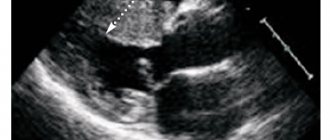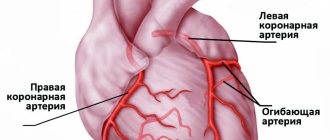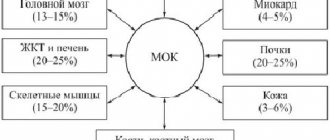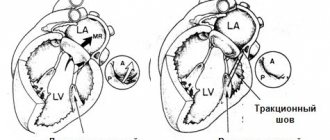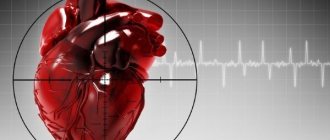Causes
It is necessary to clarify that this disease can also develop due to other heart diseases, and this leads to special forms of development. In addition to negative factors such as disease, myocardial remodeling can also occur as a consequence of poor quality treatment. It is important to know that completely different reasons influence the development of one or another physiological feature of the heart. There is no need to talk about the importance of correctly diagnosing the causes of occurrence, because it is already clear that you should first of all pay attention to the factor that contributed to the occurrence of this anatomical change.
Read it! Type 1 LV diastolic dysfunction: what it is, causes of development, methods of treatment
Due to high blood pressure, certain diseases arise that lead to these changes. In addition to these heart deformations, other abnormalities can also be observed:
- the thickness of cardiomyocytes has an accelerated growth;
- the number of sarcomeres increases;
- the heart walls increase in size.
Attention! Cardiomyocytes are the mononuclear cells that make up the myocardium. They, in turn, have a transverse arrangement, and cause increased strength of muscle mass.
Of great importance is the scale of myocardial remodeling, which has different meanings and is explained by two main causes:
| activation of neurohormones | A similar case occurs as a result of damage to the body by myocardial infarction. It is worth saying that this activation is due to significant damage to the heart muscle. By the way, this increased activation should work to regulate the overall functioning of the cardiac organ and normalize blood pressure. But, if precautions are not taken in time, this pathology develops into a more severe form of myocardial remodeling |
| sympathetic nervous system and its activation | This cause of the underlying disease is explained by increased tension in the left ventricle. This leads to the fact that this section requires more oxygen. |
If we talk about eccentric myocardial remodeling, it can be caused by significant overload of this muscle tissue. In addition, this is accompanied by elongation of mononuclear cells and a decrease in the size of the heart walls.
Interesting! But functional remodeling provokes a decrease in myocardial contractility. This problem is absolutely independent of geometric and atomic changes in muscle tissue.
Cardiac remodeling
There is nothing more difficult than suffering from severe heart disease, which also leads to certain consequences. One of these is cardiac remodeling. Heart remodeling is a structural change in an organ that destroys its properties in response to external influences and other pathological processes in the human body.
Heart remodeling occurs under the influence of negative factors and diseases
Formation of “perestroika”
Scheme of the formation of two types of myocardial dysfunction
You can find the definition of hypertrophy as remodeling. These terms are synonymous with each other, although it is correct to say that hypertrophy is a particular remodeling. The second concept is broader. Remodeling means the process of changing an existing structure, rebuilding it, or adding something to it. Myocardial remodeling is a change in its geometric structure under the influence of a specific factor. Moreover, not only the structure is being rebuilt, but functional restructuring is also taking place.
The purpose of remodeling is to adapt the left ventricle to the established hemodynamic conditions, which often become pathological. With the constant influence of increased pressure on the LV myocardium, there is a response increase in the number of sarcomeres and the thickness of the heart cell (cardiomyocytes). As a result, the LV wall thickens, which occurs with concentric remodeling of the left ventricular myocardium. In the case of eccentric remodeling, the ventricle experiences volume overload. In this case, the cardiomyocytes are stretched, and the wall of the heart chamber decreases.
Remodeling
The following components are involved in the development of left ventricular (LV) myocardial remodeling:
- Myocardial cells are cardiomyocytes. Cardiomyoitis are highly differentiated structures. This means that these cells have lost the ability to divide. Therefore, in response to increasing physical activity (PE), the concentration of biologically active substances in the body increases: norepinephrine, angiotensin, endothelin, etc. In response to this, the number of sarcoplasmic contractile units in cardiomyocytes increases. Energy exchange processes begin to occur more intensively in the cell.
- Fibroblasts are components of connective tissue. While the myocardium thickens and hypertrophies, the vessels do not have time to provide such muscle mass with oxygen and nutrients. Oxygen requirements increase, but the vascular network remains at the same level. The LV myocardium enters a state of ischemia—oxygen starvation. In response to this, connective tissue components—fibroblasts—are activated. “Growing” with connective tissue, the myocardium loses its elasticity and becomes rigid. This circumstance entails a decrease in diastolic function of the left ventricle. In simple terms, diastolic dysfunction of the left ventricle (LV) appears.
- Collagen. In various diseases, in particular myocardial infarction, collagen, which ensures the relationship between cardiomyocytes, begins to weaken and disintegrate. The process of collagen formation does not keep pace with its breakdown in the first weeks of a heart attack. Then these processes are leveled out, and in place of weakened cardiomyocytes that have undergone necrosis during a heart attack, a connective tissue scar is formed.
How is it diagnosed and can the pathology be stopped?
Diagnosis of this disease is carried out by taking an electrocardiogram of the heart. On it, if the geometry of the left ventricle of the myocardium changes, an increase in ST and a decrease in the R wave will be observed.
The development of myocardial remodeling can be prevented if hypertension is diagnosed in a timely manner (it is characterized by frequent upward pressure surges, headaches, and deterioration in general health).
Modern medicine proves that even existing pathology can be reduced with the help of medications and more. It is possible to reduce the thickness of the walls and reduce the mass of the left ventricle with the help of antihypertensive drugs.
Beta-blockers inhibit remodeling and improve the geometry of the left ventricle of the myocardium. In addition, on the first day after a heart attack, angiotensin-converting enzyme inhibitors are prescribed to prevent heart failure and prevent relapse. Nitrates, as well as calcium antagonists (they require a long course of therapy), are effective in limiting early post-infarction remodeling.
It is also important to reduce your intake of salt and pickles, follow a specially designed diet and take control of your own weight (prevent the formation of excess kilograms).
Myocardial remodeling using the example of changes after a heart attack
For a more clear idea of the pathological process, we can consider the main points of the pathophysiology of myocardial remodeling using the example of its structural changes after a heart attack. First of all, the shape of the left ventricle changed. If earlier its shape was an ellipse, now it looks more like a sphere. The thinning and stretching of the myocardium is very clearly observed, the area of necrosis of the area of the heart muscle often increases (even in cases where there were no repeated ischemic necrosis). Many other pathological disorders also appear that can lead to unpleasant consequences.
The interrelation of the processes during which a structural change develops in the heart muscle is obvious: first, the pressure increased, the heart tries to adapt in response to it, as a result, in direct proportion, the thickening of the ventricular wall occurs, and at the same time the weight of the muscle and some others increases, changes corresponding to a given state.
This example explains how myocardial remodeling occurs and why it can be dangerous and worsen the situation, increasing the risk of complications after a heart attack. That is why, after an attack, the patient undergoes a long period of rehabilitation; he is prescribed special medications (some of which are used continuously) to prevent the development of a relapse.
Pathophysiology of the process
If we talk about the pathophysiology of myocardial remodeling, then changes after a heart attack manifest themselves as follows:
- change in the shape of the left ventricle. If before the attack it was ellipsoidal, now it has become closer to spherical,
- the heart muscle is thinned. Its stretching is observed,
- an increase in the necrotic part of the myocardium. It can happen even in the absence of a recurrent attack.
It should be noted that thanks to the capabilities of modern medicine, the survival rate after MI has become much higher. But the remodeling process has not yet been prevented, because it is a natural consequence of an unbroken chain of natural stages. The only thing that depends on the person himself is the ability to minimize the consequences of a heart attack. To do this, it is enough to follow the recommendations of the attending physician regarding the rehabilitation period, and also do not forget about the rules for preventing a recurrent attack.
How to stop the disease?
Heart remodeling can cause the following diseases: stroke, chronic heart failure, ischemia, necrosis of cardiac cells, and heart attack. Therefore, it is very important to correctly calculate optimal physical activity, as well as promptly check with a doctor if you suspect the appearance of an illness. If this heart pathology is detected, sudden cessation of training is contraindicated. Physical activity should be calculated by a specialist and gradually reduced. With a timely and qualified approach, the heart has a chance to return to its original shape.
Remodeling after MI
The main factor contributing to the development of remodeling is neurohormonal activation. It is observed after a person has suffered a myocardial infarction. The activity of neurohormones is directly comparable to the extent of damage to the heart muscle. Initially, it helps normalize blood pressure and heart activity. But after some time, the activity of hormones becomes pathological. As a result, the remodeling process accelerates, acquiring greater proportions, and chronic heart failure develops, which poses a danger to human health and life.
The next factor is the activation of the sympathetic nervous system. It contributes to an increase in the tension of the left ventricle, as a result of which the myocardial need for oxygen increases.
